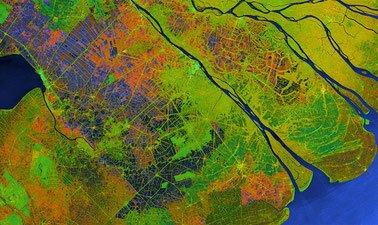MOOC List is learner-supported. When you buy through links on our site, we may earn an affiliate commission.

MOOC List is learner-supported. When you buy through links on our site, we may earn an affiliate commission.
Remote sensing observations from airborne and spaceborne platforms have become an essential tool in disaster management. They provide an immediate and large-area overview of evolving disaster situations, revealing important hazard information to disaster response personnel.
This course will introduce you to Synthetic Aperture Radar (SAR), a remote sensing technology that can see the ground even during darkness and through rain, clouds, or smoke. As a participant in this course, you will gain an intuitive understanding of the information contained in SAR observations and learn to use a range of analysis techniques to apply SAR data to disaster mapping and management. Specific topics will include:
- The mathematical and physical principles of SAR remote sensing
- How to access and visualize SAR data
- Interpretation of SAR images in the context of disaster monitoring
- Interferometric SAR (InSAR) concepts
- Flood mapping and SAR change detection for hazard analysis
The learned concepts will be put into action in simulated disaster response exercises, in which class participants will analyze SAR data sets to create hazard information for several real-life disaster events from the recent past.
Learners registered for the verified track will additionally get the opportunity for hands-on lab exercises using Jupyter Notebooks. The verified track will also include peer discussions and a verified certificate upon successful completion.
This course is part of the Synthetic Aperture Radar (SAR): Applications Professional Certificate.
Prerequisites:
- General proficiency in GIS
- For verified track: Basic knowledge in Python programming
- ARSET Level-0 Training “Fundamentals of Remote Sensing” or equivalent
- ARSET Level-1 Training “Introduction to Synthetic Aperture Radar” or equivalent
What you'll learn
Participants in this course will develop the following skills:
- Intuitive understanding of SAR image and phase information
- Understanding the properties of different SAR sensor types
- Ability to pick the optimal sensor for your application
- Creation of RGB color visualizations from images acquired at different times or in different polarizations
- Use of SAR images to map hazards such as flooding and deforestation
- Use of interferometric SAR techniques to measure cm-scale surface deformation related to volcanic activity and landslides
Syllabus
Week 1: Course Introduction and Basic Capabilities of SAR & InSAR
Week 1 will introduce you to the main content and structure of this course. You will also learn about the lab environment that will be available for learners on the “verified track”. The following items will be addressed:
- Introduction to course
- Presentation of course syllabus
- Basic principles and capabilities of Synthetic Aperture Radar (SAR) imaging
- Concepts of Interferometric SAR processing and its applications to disaster monitoring
- Verified Track: Lab exercise on exploring SAR time series for flooding events
- Verified Track: Lab exercise analyzing and interpreting InSAR products
Week 2: InSAR Time Series Analysis Techniques
InSAR time series analysis techniques enable the tracking of cm-scale surface displacements over long times. These techniques are relevant for a number of hazard applications such as landslide and volcano monitoring. In Week 2 we will address:
- The Concept of InSAR Time Series Analysis
- Point Target-Based InSAR Time Series Analysis
- Distributed Scatterer InSAR Time Series Analysis
- Verified Track: Lab exercise exploring PSI time series data over Norway
Week 3: Disaster Monitoring using SAR Image Data
SAR sensors are highly stable imaging systems that are ideal for the identification of changes on the earth surface. Week 3 will introduce participants to a range of techniques to monitor hazard events and identify changes from multi-temporal SAR images.
- Surface water signatures in SAR
- A Threshold-based surface water mapping method
- Verified Track: Hands-on flood mapping using Jupyter Notebooks
- SAR change detection techniques
- Verified Track: Lab exercise on time series change detection to map deforestation
Week 4: Disaster Monitoring using InSAR Techniques
In this part of the course, we will apply the information learned in Week 4 to monitor surface displacements at volcanoes and in landslide-prone areas. Specifically, Week 6 will address the following items:
- Review of InSAR workflow for a geophysical application
- Estimating volcano source model parameters from InSAR
- Verified Track: Lab exercise estimating Mogi source parameters for Okmok volcano, Alaska
- Landslides monitoring using SBAS InSAR
- Verified Track: Lab exercise mapping landslide motion in California using InSAR time series data
MOOC List is learner-supported. When you buy through links on our site, we may earn an affiliate commission.
MOOC List is learner-supported. When you buy through links on our site, we may earn an affiliate commission.
